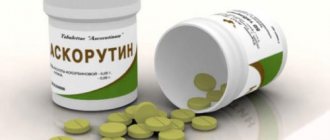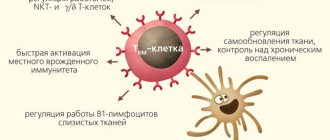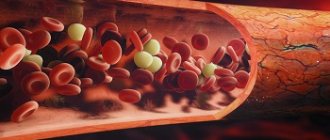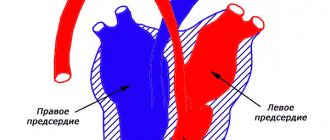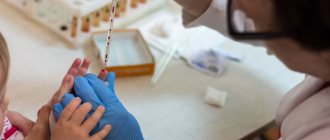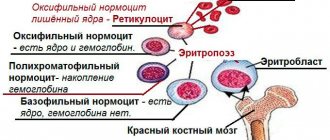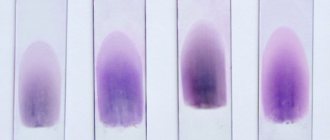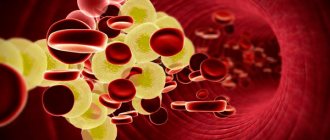Content
- 1 Heparin 1.1 Chemical properties and mechanism of action 1.1.1 Related glycosaminoglycans
- 1.1.2 Sources
- 1.3.1 Other properties of heparin
- 2.1 Pharmacokinetics
- 2.3.1 Bleeding
Use during pregnancy and lactation
Heparin solution is not contraindicated for pregnant women. However, despite the fact that the active substance of the drug does not penetrate into milk, its use in nursing mothers in some cases led to the rapid (within 2-4 weeks) development of osteoporosis and spinal damage.
The feasibility of use should be decided individually, taking into account the risk to the fetus/benefit to the mother ratio.
There are no data on the use of the gel during pregnancy and lactation.
Heparin[edit | edit code]
Historical reference
. In 1916, medical student McLane, who was studying the nature of ether-soluble procoagulants, was lucky enough to discover a phospholipid anticoagulant. Shortly thereafter, Govell, in whose laboratory McClain worked, discovered a water-soluble glycosaminoglycan, named heparin because of its high content in the liver (Jaques, 1978). Heparin's success in preventing coagulation in vitro led to its later use in the treatment of venous thrombosis.
Chemical properties and mechanism of action[edit | edit code]
Heparin
- glycosaminoglycan found in mast cell granules. During its synthesis, a polymer consisting of alternating D-glucuronic acid and N-acetyl-glucosamine residues is formed from various UDP sugars (Bourin and Lindahl, 1993). Approximately 10-15 such glycosaminoglycan chains (200-300 monosaccharides each) are attached to the protein part of the molecule, forming a proteoglycan with a molecular weight of 750,000-1,000,000. Then modification of the glycosaminoglycan chains occurs: N-deacetylation and N-sulfation of glucosamine residues, epimerization D-glucuronic acid into L-iduronic acid, O-sulfation of residues of these acids in position 2, O-sulfation of glucosamine residues in positions 3 and 6 (Fig. 55.2). Since these reactions do not affect all monosaccharides, the structure of the resulting molecules is quite diverse. The glycosaminoglycan chains of heparin transferred to mast cell granules are cleaved by p-glucuronidase into fragments with a molecular weight of 5000-30,000 (on average about 12,000, that is, 40 monosaccharides) within a few hours.
Related glycosaminoglycans[edit | edit code]
Heparan sulfate is present on the cell membrane of most eukaryotic cells and in the extracellular matrix. It is synthesized from the same repeating disaccharide sequences as heparin (D-glucuronic acid and N-acetylglucosamine), but undergoes less modification and therefore contains more D-glucuronic acid and N-acetylglucosamine and fewer sulfate groups. Heparan sulfate also has anticoagulant properties in vitro, but at much higher concentrations.
Dermatan sulfate is a polymer of L-iduronic acid and N-acetylgalactosamine with varying degrees of O-sulfation of L-iduronic acid at position 2 and galactosamine at positions 4 and 6. Like heparan sulfate, dermatan sulfate is present on the cell membrane and in the extracellular matrix and has anticoagulant properties in vitro.
Sources[edit | edit code]
Heparin is usually obtained from bovine lung or porcine intestinal lining. Such drugs may contain a small admixture of other glycosaminoglycans. Although the composition of heparins from different manufacturers is somewhat different, their biological activity is approximately the same (about 150 units/mg). 1 unit is taken to be the amount of heparin that prevents the clotting of 1 ml of citrated sheep plasma within an hour after adding 0.2 ml of 1% CaCl2.
Low molecular weight heparins with a molecular weight of 1000–10,000 (average 4500, i.e. 15 monosaccharides) are obtained from a conventional preparation by gel filtration, ethanol precipitation or partial depolymerization using nitrous acid and other reagents. Low molecular weight heparins differ from regular heparins and from each other in pharmacokinetic properties and mechanism of action (see below). Their activity is usually determined by inhibition of factor Xa.
Physiological role[edit | edit code]
Heparin is found in tissues inside mast cells. It appears to be required for the storage of histamine and some proteases within the granules of these cells (Humphries et al., 1999; Forsberg et al., 1999). Once released from mast cells, heparin is quickly taken up and destroyed by macrophages. It cannot be detected in the plasma of healthy people. However, in patients with systemic mastocytosis with massive degranulation of mast cells, a slight prolongation of the aPTT is sometimes observed, presumably associated with the release of heparin into the bloodstream.
Heparan sulfate molecules on the surface of endothelial cells and in the extracellular matrix of the subendothelial layer interact with antithrombin III, preventing thrombus formation. With malignant neoplasms, bleeding is sometimes observed, caused by heparan sulfate or dermatan sulfate entering the bloodstream (probably due to tumor disintegration).
Mechanism of action[edit | edit code]
In 1939, Brinkhaus et al. discovered that the anticoagulant effect of heparin is mediated by one of the plasma components and called it the heparin cofactor. Thirty years later, it was discovered to be antithrombin III, a plasma protein that rapidly inactivates thrombin in the presence of heparin (Olson and Bjork, 1992). Antithrombin III is a glycosylated single-chain polypeptide with a molecular weight of approximately 58,000, homologous to the serpin family (spin yrothease inhibitors), in particular agantitrypsin. Antithrombin III is synthesized in the liver, its serum concentration is 2.6 µmol/l. It is active against factors of the intrinsic and general coagulation mechanisms (in particular, 1Xa, Xa and thrombin), but has little effect on factor Vila. The mechanism of the inhibitory effect of antithrombin III is as follows. The listed coagulation factors, as already mentioned, are proteases. Antithrombin III acts as their substrate: active coagulation factors attack a specific peptide bond between arginine and serine in the reactive center of its molecule. However, cleavage of this bond does not occur, and a stable complex is formed from the coagulation factor and antithrombin III in an equimolar ratio. As a result, the coagulation factor loses its proteolytic activity.
Heparin accelerates the interaction of antithrombin III with thrombin by more than 1000 times due to the fact that it serves as a matrix linking both proteins. Binding to heparin also changes the conformation of antithrombin III, making its reactive site more accessible to thrombin (Jin et al., 1997). After the formation of the thrombin-antithrombin III complex, the heparin molecule is released. The region of the heparin molecule responsible for binding to antithrombin III is a pentasaccharide sequence containing a glucosamine residue O-sulfated at position 3 (Fig. 55.2). This structure is found in approximately 30% of heparin molecules and, less commonly, in heparan sulfate. Other glycosaminoglycans (dermatan sulfate, chondroitin sulfates) lack this structure and are not able to activate antithrombin III. Heparins with a molecular weight of less than 5400 (containing less than 18 monosaccharides) cannot bind both antithrombin III and thrombin and therefore do not accelerate the inactivation of the latter. At the same time, shown in Fig. 55.2 pentasaccharide catalyzes the inhibition of factor Xa by antithrombin III (apparently, only conformational changes in antithrombin III are sufficient for this). This explains the anticoagulant effect of low molecular weight heparins, most of whose molecules are too short to bind thrombin.
Antithrombin III quickly (T1/2 <0.1 s) inhibits factors 1Xa, Xa and thrombin at plasma heparin concentrations of 0.1 - 10 units/ml. At the same time, the aPTT and thrombin time (plasma clotting time when thrombin is added) are prolonged; PV changes less. Factor Xa on the surface of platelets (as part of the prothrombinase complex) and thrombin bound to fibrin are not inhibited by heparin and antithrombin III.
Figure 55.2. Antithrombin-binding region of the heparin molecule.
Thus, heparin accelerates the inactivation of factor Xa and jumbin only after they are released from their binding sites. Platelet factor 4, released from α granules during platelet aggregation, interferes with the binding of antithrombin III to heparin and heparan sulfate, promoting thrombus formation at the site of clotting.
When the concentration of heparin or dermatan sulfate is above 5 units/ml, their inhibitory effect on thrombin is mediated primarily by the heparin cofactor P. Heparin also stimulates the suppression of thrombin activity by plasminogen antiactivator 1, protein C inhibitor and nexin-1 protease and factor Xa activity by an inhibitor of the extrinsic coagulation mechanism. The concentrations of the last four inhibitors in plasma are more than 100 times less than the concentration of antithrombin III. IV administration of heparin increases the concentration of the inhibitor of the extrinsic coagulation mechanism several times (possibly causing its release from binding sites on the endothelium).
Other properties of heparin[edit | edit code]
High doses of heparin may prolong bleeding time by interfering with platelet aggregation. It is not clear whether the antiplatelet effect of heparin contributes significantly to the bleeding it causes. Heparin clarifies chylous plasma, causing the release of lipoprotein lipase into the bloodstream, which breaks down triglycerides into fatty acids and glycerol. This phenomenon is observed even at low concentrations of heparin, insufficient to exhibit an anticoagulant effect. After discontinuation of the drug, rebound hyperlipoproteinemia is possible.
Heparin inhibits the growth of many cells in culture, including endothelial and vascular smooth muscle cells, as well as renal mesangial cells. In animal experiments, it prevented the proliferation of vascular smooth muscle cells after damage to the endothelium of the carotid arteries. This effect of heparin is in no way related to its anticoagulant activity (Wright et al., 1989).
Acid and basic fibroblast growth factors have a high affinity for heparin. These factors stimulate the growth of smooth muscle, endothelial and other mesenchymal cells, as well as angiogenesis. Heparin itself suppresses the growth of capillary endothelial cells, but at the same time potentiates the effect of acidic fibroblast growth factor on these cells (Sudhal-tere et al., 1989). This effect does not depend on its anticoagulant activity, but on the size and degree of sulfation of heparin molecules. Heparan sulfate on the surface of mesenchymal cells serves as a low-affinity binding site for basic fibroblast growth factor, and in the extracellular matrix it stabilizes this factor and acts as a depot from which basic fibroblast growth factor is released under the action of heparin sulfate lyase or excess heparin. In addition, like heparin, it is necessary for the biological activity of basic fibroblast growth factor, facilitating its binding to a high-affinity receptor with its own tyrosine kinase activity (Yayon et al., 1991).
Side effects
When used externally, Heparin sodium can cause skin hyperemia and hypersensitivity reactions.
When administering the solution, the following are possible:
- Hypersensitivity reactions ( drug fever , skin hyperemia, rhinitis , feeling of heat in the soles, urticaria , skin itching, collapse, bronchospasm , anaphylactic shock ).
- Headaches, dizziness, diarrhea, loss of appetite, nausea, vomiting;
- Thrombocytopenia (in approximately 6% of patients), sometimes (rarely) with death. Heparin-induced thrombocytopenia (HIT) is accompanied by: arterial thrombosis , skin necrosis and gangrene , stroke , myocardial infarction . In case of severe HIT (when the platelet is reduced to half the original number or below 100 thousand/μl), heparin should be stopped immediately.
- Local reactions ( hematoma , hyperemia , pain, ulceration, irritation at the injection site, bleeding).
- Bleeding. Typical ones are considered to be from the urinary tract and gastrointestinal tract, in areas that are subject to pressure, at the site of drug administration, from surgical wounds. Hemorrhages are also possible in various internal organs: in the retroperitoneal space, corpus luteum, adrenal glands, etc.
With long-term use of Heparin, intermittent alopecia , osteoporosis , hypoaldosteronism , soft tissues become calcified, spontaneous bone fractures occur, and the activity of liver transaminases increases.
Application[edit | edit code]
Heparin begins to act quickly, which makes it possible to use it for venous thrombosis and pulmonary embolism. The duration of treatment is usually 4-5 days. Indirect anticoagulants are also immediately prescribed orally, which by the time heparin is discontinued begin to act in full force (see below). For thrombosis and embolism that recurs during conventional treatment with indirect anticoagulants (for example, with Trousseau's syndrome), long-term heparin therapy is performed. Heparin is also used: for unstable angina and myocardial infarction; with balloon coronary angioplasty and stent installation; during operations requiring artificial circulation; in some patients with DIC syndrome. Low doses of heparin successfully prevent venous thrombosis and pulmonary embolism in patients at risk (for example, after surgery on bones and joints). More recently, detailed recommendations for the use of heparin have been developed (Proceedings of the American College of Chest Physicians 5th Consensus Conference on Antithrombotic Therapy, 1998).
The first indication for the use of low molecular weight heparins approved by the FDA was the prevention of venous thrombosis and pulmonary embolism. They have recently been shown to be effective in venous thrombosis, pulmonary embolism and unstable angina (Hirsh et al., 1998a). Their main advantage over conventional heparin is their more predictable pharmacokinetics, which allows them to be prescribed subcutaneously without laboratory control (see below). This makes it possible to treat many patients at home. In addition, treatment with low molecular weight heparins is less likely to be complicated by heparin thrombocytopenia and, apparently, osteoporosis and bleeding.
Unlike warfarin, heparin does not cross the placenta and does not cause malformations, which makes it possible to prescribe it to pregnant women. Heparin does not increase perinatal mortality or the risk of preterm birth (Ginsberg et al., 1989a, b). To reduce the risk of postpartum hemorrhage, it is advisable to stop heparin one day before delivery. The use of low molecular weight heparins in pregnant women has not been studied enough.
Pharmacokinetics[edit | edit code]
Heparin is not absorbed from the gastrointestinal tract, and therefore it is administered subcutaneously or by intravenous infusion. When administered intravenously, the drug begins to act immediately. On the contrary, with subcutaneous administration, its bioavailability can vary greatly, and the effect appears only after 1-2 hours. The bioavailability of low molecular weight heparins is approximately the same.
T1/2 of heparin depends on the dose. When administered intravenously at a dose of 100, 400 and 800 units/kg, its anticoagulant activity is reduced by half in 1, 2.5 and 5 hours, respectively (Appendix II). Heparin destruction occurs mainly in macrophages; a small amount of the drug is excreted unchanged in the urine. T1/2 of heparin can be slightly shortened in pulmonary embolism and lengthened in the terminal stages of liver cirrhosis and chronic renal failure. Low molecular weight heparins have a slightly higher T1/2.
Doses and laboratory control[edit | edit code]
Standard doses of heparin are usually administered by IV infusion. Treatment of venous thrombosis and pulmonary embolism begins with the administration of 5000 units of heparin as a bolus, followed by infusion at a rate of 1200-1600 units/hour. Treatment is monitored by determining the APTT. The therapeutic dose of heparin is considered to be a dose corresponding to a plasma heparin concentration of 0.3-0.7 units/ml, determined by anti-Xa activity (Hirsh et al., 1998a). APTT values corresponding to these heparin concentrations depend on the equipment and reagents used. It is usually considered sufficient to prolong the aPTT by 1.7-2.5 times, but some kits for determining the aPTT overestimate this figure, resulting in the prescription of insufficient doses of heparin. Administration of insufficient doses on the first day increases the risk of repeated thrombosis and embolism. APTT is determined before treatment and then every 6 hours; Based on these data, the dose of the drug is adjusted using nomograms (Raschke et al., 1993). When dose selection is completed, monitoring can be carried out once a day.
Prevention of blood clotting during artificial circulation requires very large doses of heparin. In this case, the aPTT lengthens so much that it becomes uninformative, so other tests (for example, activated clotting time) are used to control healing.
If long-term treatment with anticoagulants is necessary in a situation where warfarin is contraindicated (for example, during pregnancy), heparin can be administered subcutaneously. With a daily dose of about 35,000 units (in 2-3 doses), the APTT, determined in the interval between administrations, is usually prolonged by 1.5 times. After dose selection, further monitoring is usually not required.
Small doses of heparin are prescribed prophylactically to patients with a tendency to deep vein thrombosis and pulmonary embolism. Recommended administration regimen: 5000 units subcutaneously 2-3 times a day. Since the aPTT is not prolonged, laboratory monitoring is not needed.
Low molecular weight heparins (enoxaparin, dalteparin, ardeparin, nadroparin, reviparin, tinzaparin; in the USA today only the first three are used) are very different in composition. Comparable anti-Xa activity of any two drugs does not guarantee their identical antithrombotic effect. Low molecular weight heparins are administered subcutaneously 1-2 times a day. Since they have little effect on blood clotting parameters, laboratory monitoring is usually not needed. In the terminal stage of chronic renal failure, T./2 of low molecular weight heparins is prolonged, which requires control of anti-Xa activity. Specific instructions for using specific medications can be found in the instructions that come with them.
Heparin resistance[edit | edit code]
The doses of heparin required to prolong the aPTT depend on the plasma levels of heparin-binding proteins (eg, histidine-rich glycoprotein, vitronectin, and platelet factor 4), which competitively inhibit the interaction of heparin with antithrombin Ill. Sometimes even very large doses of heparin (more than 50,000 units/day) do not prolong the aPTT. At the same time, the concentration of heparin in plasma, measured by other methods (for example, using protamine sulfate titration or anti-Xa activity), formally remains therapeutic. Some of these patients initially have a sharply shortened aPTT due to high factor VIII concentrations and may not have true heparin resistance. In other patients (for example, with massive pulmonary embolism), drug elimination is enhanced. Patients with hereditary antithrombin III deficiency usually respond well to heparin therapy, since their antithrombin III concentration is 40-60% of normal. However, in case of acquired deficiency with an antithrombin III concentration below 25% of the norm (with cirrhosis of the liver, nephrotic syndrome, LVS syndrome), there may be no effect even with the administration of large doses of heparin.
Side effects[edit | edit code]
Bleeding[edit | edit code]
The main complications of heparin therapy are hemorrhagic. Severe bleeding was noted by various researchers in 1-33% of patients; In a water study of 647 patients, there were 3 deaths (Levine and Hirsh, 1986). In recent studies of patients with PE, severe bleeding was observed in less than 3% of patients receiving IV heparin (Levine et al., 1998). Comparable data were obtained in the treatment of pulmonary embolism with low molecular weight heparins. In general, the risk of bleeding increases with increasing daily dose and aPTT, but the correlation between these indicators is weak, and bleeding can occur even with therapeutic aPTT values. They are usually caused by concomitant pathology, such as recent operations, trauma, peptic ulcer disease or thrombocytopathies.
The anticoagulant effect of heparin ceases a few hours after discontinuation of the drug. For mild bleeding, there is usually no need to prescribe the antidote heparin. For life-threatening bleeding, the effects of heparin can be quickly reversed by a slow infusion of protamine sulfate, a mixture of essential polypeptides obtained from salmon sperm. Protamine binds tightly to heparin, neutralizing its anticoagulant effect. It also binds to platelets, fibrinogen and other plasma proteins and can itself cause bleeding. Therefore, only the minimum dose of protamine sulfate should be administered to ensure neutralization of heparin. This dose is usually 1 mg for every 100 units of heparin remaining in the body, and is administered intravenously slowly (up to 50 mg over 10 minutes).
Protamine sulfate is usually used to reverse the effects of heparin after heart and vascular surgery. Anaphylactic reactions occur in approximately 1% of diabetic patients treated with protamine-containing insulins (NPH insulin or protamine-zinc insulin), but also occur in other patients. Less commonly observed reactions are pulmonary vasospasm, right ventricular failure, arterial hypotension and transient neutropenia.
Heparin thrombocytopenia[edit | edit code]
This diagnosis is made when the platelet count decreases below 150,000 μl~' or by 50% of the initial level. It occurs in approximately 3% of patients after 5-10 days of treatment with conventional heparin (Warkentin, 1999). Low molecular weight heparins are less likely to cause thrombocytopenia. One third of patients with this complication develop severe thrombosis (sometimes life-threatening or requiring limb amputation), which may precede thrombocytopenia. The most common are venous thrombosis and pulmonary embolism, but thrombosis of peripheral arteries, myocardial infarction, and stroke are also possible. Heparin thrombocytopenia may be accompanied by bilateral adrenal necrosis, skin lesions at injection sites and various systemic reactions. The cause of these complications is considered to be the production of IgG antibodies to the complex of heparin with platelet factor 4 (less often with other chemokines). These complexes bind to platelet Fcyl 1a receptors, causing platelet aggregation, the release of even more platelet factor 4, and the formation of thrombin. In addition, antibodies can damage the vascular wall by binding to the complex of platelet factor 4 and heparan sulfate on the surface of the endothelium.
The appearance of thrombocytopenia or other complications mentioned above after 5 days of heparin therapy or later (regardless of the dose or route of administration) requires immediate discontinuation of the drug. In patients who have received heparin in the previous 3-4 months, heparin thrombocytopenia may develop more quickly due to remaining antibodies. The diagnosis can be confirmed by identifying antibodies to the heparin complex with platelet factor 4, as well as by studying heparin-dependent platelet activation. Since thrombosis may occur after discontinuation of the drug (Wallis et al., 1999; Warkentin, 1999), other anticoagulants are prescribed for heparin thrombocytopenia - lepirudin or danaparoid (see below). Low molecular weight heparins cannot be used in such cases, as they often cross-react with antibodies to regular heparin. Warfarin in patients with parin thrombocytopenia can cause wet gangrene (Warkentin et al., 1997) or multiple skin necrosis (Warkentin et al., 1999), it can be prescribed only after thrombocytopenia has been eliminated and treatment with other anticoagulants.
Other complications[edit | edit code]
In patients receiving heparin intravenously or subcutaneously, aminotransferase activity is often slightly increased with normal bilirubin levels and normal alkaline phosphatase activity. Long-term treatment with therapeutic doses of heparin (more than 20,000 units/day for, for example, 3-6 months) sometimes, although rarely, causes osteoporosis with vertebral compression fractures. Heparin, even in small doses, inhibits the synthesis of aldosterone in the adrenal glands and occasionally causes hyperkalemia. Allergic reactions to heparin (excluding thrombocytopenia) are rare.
Indications for use
Indications for use of the gel
Heparin gel is used for the treatment and prevention of thrombophlebitis of the superficial veins , phlebitis (post-injection and post-infusion), lymphangitis , superficial periphlebitis, elephantiasis, localized infiltrates, bruises, swelling and injuries (including muscles, joints, tendons), superficial mastitis , subcutaneous hematomas .
Indications for use of the solution
Heparin injections are prescribed for thrombosis of deep veins , myocardial arteries , renal veins , pulmonary embolism, thrombophlebitis , atrial fibrillation (including if cardiac arrhythmia is accompanied by embolization), unstable angina , disseminated intravascular coagulation syndrome , acute myocardial infarction, mitral heart disease (prevention of blood clots ), bacterial endocarditis , hemolyticouremic syndrome , lupus nephritis , glomerulonephritis , for the prevention and treatment of microthrombosis and microcirculation disorders.
For preventive purposes, the drug is used during surgical interventions that use extracorporeal blood circulation methods, during cytapheresis, peritoneal dialysis, hemodialysis, forced diuresis, hemosorption, and when washing venous catheters.
When Heparin is administered intravenously, blood clotting slows down almost immediately, when administered into a muscle - after 15-30 minutes, when administered subcutaneously - after 20-60 minutes, when administered by inhalation, the effect is most pronounced after 24 hours.
Read also[edit | edit code]
- Treatment of thrombosis
- Hirudin
- Fibrinolytics
- Thrombosis
- Antiplatelet agents
- Plasma substitutes
- Hemostasis
- Drugs that affect blood clotting
- Hemostatics (coagulants, fibrinolysis inhibitors)
- Agents that reduce vascular permeability
- Anticoagulant blood system
- Direct anticoagulants
- Indirect anticoagulants
- Agents affecting fibrinolysis
- Agents affecting platelet aggregation
Interaction
Drugs that block tubular secretion, indirect anticoagulants that reduce the formation of vitamin K by intestinal microflora, antibiotics, NSAIDs, dipyridamole , ASA and other drugs that reduce platelet aggregation enhance the effect of heparin.
The weakening of the effect is facilitated by: cardiac glycosides , ergot alkaloids , phenothiazines , antihistamines, nicotine , ethacrynic and nicotinic acids , nitroglycerin (iv administration), ACTH, tetracyclines , alkaline amino acids and polypeptides, thyroxine , protamine .
Do not mix the solution in the same syringe with other medications.
When applied topically, the anticoagulant effect of the drug is enhanced when the gel is used in combination with antiplatelet agents, NSAIDs, and anticoagulants. Tetracycline , thyroxines , nicotine and antihistamines reduce the effect of heparin.
Contraindications
Heparin is not recommended for patients with personal intolerance and in the case of:
- hypersensitivity to the components that make up the drug;
- bleeding of various nature (excluding cases when the use of the drug is not associated with a risk to the patient’s condition);
- diseases of heparin-induced thrombocytopenia;
- Gregoire's disease;
- hemorrhagic diathesis and pathologies related to insufficient blood clotting;
- high vascular permeability;
- subacute bacterial endocarditis;
- leukemia;
- pathological local protrusion of the heart wall at the site of its thinning;
- aplastic and hypoplastic anemia;
- intracranial injuries;
- pathologies of the central nervous system, etc.
Prescription of the drug is possible only by a doctor after he has assessed the patient’s health condition.
Reviews
Heparin is an effective and well-studied antithrombotic agent , the mechanism of action of which is to suppress the activity of thrombin , which catalyzes the biotransformation of fibrinogen into fibrin and a number of other reactions in the hemostatic system.
Most often, the external use of gel and ointment forms of the drug is discussed on the Internet. Reviews of heparin-containing ointments and gels (in particular, reviews of Heparin Acrigel 1000 ) are overwhelmingly positive: such drugs really help with bruises, thrombophlebitis and hemorrhoids , and also remove localized infiltrates well.
Signs of heroin use
When administered intravenously, the effect appears within one minute, and sometimes within 10-15 minutes. If the substance is added to a smoking mixture, euphoria occurs after 15-25 minutes. Once it enters the brain, it is converted into morphine. Therefore, a person feels perfect - all problems disappear, a feeling of limitless strength appears, and a pain-relieving effect occurs. The thing is that diacetylmorphine particles have a lot in common in structure with endorphin, which leads to a lift in mood and boundless happiness. Gradually, the amount of endorphins reaches enormous values, which leads to the opposite effect. Therefore, the first sign of use is panic attacks, suspiciousness and anxiety, sudden mood swings.
Fact: heroin negatively affects the central nervous system, so gradually nerve cells die and are not restored.
There are 9 signs by which you can easily identify a heroin addiction:
- Complete lack of emotion on the face. There is no facial expression, the facial muscles become exhausted and sag (the face changes).
- Eyelids and face turn red. Initially only after taking a dose, and then even in a normal state.
- Behavior is unstable. Happiness and euphoria are easily replaced by aggression and severe depression.
- The body itches and the person scratches constantly. This often happens to drug addicts with less than one year of experience.
- The eyes do not react to bright light because the pupils are constantly constricted. Often drug addicts use special drops to dilate the pupils to get rid of this effect.
- Saliva thickens and accumulates around the mouth. This is caused by the feeling of thirst. The substance leads to severe dehydration, so you constantly want to drink.
- Lost appetite. A person reaches for simple carbohydrates - buns, cookies, chocolates, sweets (to make up for the energy deficit). This leads to diseases of the gastrointestinal tract.
- Pale skin and numerous injection marks on the arms and legs. Bruises and dark spots often appear (if the injections are done incorrectly and the injection area is not treated with alcohol).
- The voice becomes rough and speech slow. Opiates have a destructive effect on the vocal cords.
At the same time, a person’s environment changes dramatically. He often changes jobs, spends time in, and rarely sees his family.
Consequences of overdose
The main symptom of an overdose of sodium heparin is bleeding. In this case, to eliminate this phenomenon, it is enough to stop using the drug. If the bleeding is quite extensive, then the activity of heparin is suppressed by prothiamine sulfate in the amount of 1 mg per 100 IU of heparin. A one percent neutralizer solution is injected into a vein at low speed. Over 10 minutes, the amount of protamine administered should not exceed 5 ml. Given the accelerated metabolism of sodium heparin, the dose of protamine sulfate should be gradually reduced.
Protamine sulfate can cause severe side effects, sometimes fatal. Its use is permitted only in hospitals with special equipment and in urgent cases.
Heparin price
The average price of Heparin injections in Ukrainian pharmacies is from 180 to 226 UAH (5 ml ampoules, No. 5). You can buy Heparin ointment for an average of 35 UAH. The price of Heparin Acrigel 1000 in Ukraine is about 250 UAH.
In Russian pharmacies, sodium heparin in ampoules can be purchased for 360-550 rubles. The price of Heparin gel is 260-300 rubles.
- Online pharmacies in RussiaRussia
- Online pharmacies in UkraineUkraine
- Online pharmacies in KazakhstanKazakhstan
ZdravCity
- Heparin solution for intravenous and subcutaneous administration.
5000IU/ml 5ml 5pcs RUP Belmedpreparaty RUR 1,506 order - Heparin-Akrikhin 1000 gel 1 thousand. IU/1g 30gAO Akrikhin
RUB 367 order
- Heparin-Akrikhin 1000 gel for external use. approx. 1000 IU/g tube 50g JSC AKRIKHIN
422 rub. order
- Heparin sodium solution for intravenous and subcutaneous administration. 5000 IU/ml 5ml 5pcs Velpharm LLC
RUB 1,589 order
- Heparin ointment 25g RUP Belmedpreparaty
70 rub. order
Pharmacy Dialogue
- Heparin-Akrikhin gel (gel 1000EM/g 50g) Akrikhin JSC
RUR 514 order
- Heparin ointment (tube 25g) Nizhpharm JSC
70 rub. order
- Heparin (solution IV, SC 5tIU/ml 5ml amp. No. 5) Belmedpreparaty
RUB 1,565 order
- Heparin-Akrikhin gel (gel 1000EM/g 30g) Akrikhin JSC
RUB 357 order
- Heparin-Akrikhin gel 1000IU/g 30gAkrikhin OJSC
RUB 353 order
show more
Pharmacy24
- Heparin-Darnitsa 600 units 30 g gel PrAT" Pharmaceutical company "Darnitsa", Ukraine
62 UAH. order - Heparin ointment 25 g TOV DKP Pharm.Fabrika, Ukraine
46 UAH order
- Heparin-Indar 5000 MO/ml 5 ml (25000 MO) No. 1 solution PrAT “On the production of insulin” Indar”, m. Kiev, Ukraine
34 UAH order
- Heparin-Novopharm 5000 MO/ml 5 ml No. 5 solution Novofarm-Biosintez TOV, Novograd-Volinsky, Ukraine
256 UAH order
PaniPharmacy
- Heparin ointment Heparin ointment 25g tube Ukraine, Zhytomyr FF LLC
60 UAH.order
- Heparin gel Heparin gel 30g Ukraine, Darnitsa ChAO
68 UAH order
- Heparin bottle Heparin solution d/in. 5000U/ml 5ml vial. №5 Ukraine, Pharmstandard-Biolek
166 UAH order
- Heparin solution d/in. 25000U/ml 5ml No.1 Ukraine, INDAR
39 UAH order
- Heparin bottle Heparin-Novopharm solution d/in 5000 MO bottle. 5ml. No.5 Ukraine, Novofarm-Biosintez LLC
268 UAH order
show more
What then
It is important to socialize the patient
. To do this, you need to redirect a person’s thoughts in a positive direction. Form a new circle of values. Instill the habit of a healthy lifestyle. In this work, doctors and workers at rehabilitation centers must be in constant contact and interaction with the patient’s relatives and friends. At the same time, it is important to understand that addiction can be overcome only if the person himself strives for this. Forced treatment never produces positive results in the long term.
Literature:
- Drugs: properties, action, pharmacokinetics, metabolism: textbook / N. V. Veselovskaya [etc.]. — 3rd ed., revised, corrected. and additional - Moscow: Narkonet, 2008. - 262 p.
- Psychotropic drugs: reference book. practicing doctor / [F. Bochner et al.] ; scientific ed. rus. ed. Yu. A. Alexandrovsky; lane English A. N. Redkin. - Moscow: Litterra Publishing House, 2006. - 292 p.
- Guide to addictionology / Axelrod B. A. et al.; edited by V. D. Mendelevich. - St. Petersburg: Rech, 2007. - 766 p.
Need some advice?
OR CALL A DOCTOR
CALL!
+7
